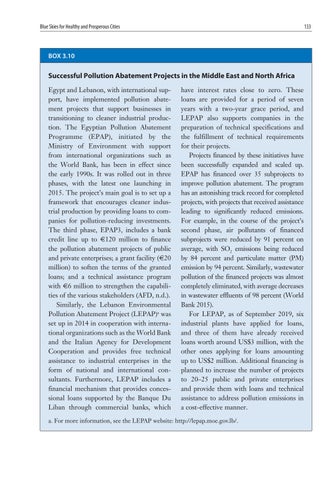Blue Skies for Healthy and Prosperous Cities
133
BOX 3.10
Successful Pollution Abatement Projects in the Middle East and North Africa Egypt and Lebanon, with international support, have implemented pollution abatement projects that support businesses in transitioning to cleaner industrial production. The Egyptian Pollution Abatement Programme (EPAP), initiated by the Ministry of Environment with support from international organizations such as the World Bank, has been in effect since the early 1990s. It was rolled out in three phases, with the latest one launching in 2015. The project’s main goal is to set up a framework that encourages cleaner industrial production by providing loans to companies for pollution-reducing investments. The third phase, EPAP3, includes a bank credit line up to €120 million to finance the pollution abatement projects of public and private enterprises; a grant facility (€20 million) to soften the terms of the granted loans; and a technical assistance program with €6 million to strengthen the capabilities of the various stakeholders (AFD, n.d.). Similarly, the Lebanon Environmental Pollution Abatement Project (LEPAP)a was set up in 2014 in cooperation with international organizations such as the World Bank and the Italian Agency for Development Cooperation and provides free technical assistance to industrial enterprises in the form of national and international consultants. Furthermore, LEPAP includes a financial mechanism that provides concessional loans supported by the Banque Du Liban through commercial banks, which
have interest rates close to zero. These loans are provided for a period of seven years with a two-year grace period, and LEPAP also supports companies in the preparation of technical specifications and the fulfillment of technical requirements for their projects. Projects financed by these initiatives have been successfully expanded and scaled up. EPAP has financed over 35 subprojects to improve pollution abatement. The program has an astonishing track record for completed projects, with projects that received assistance leading to significantly reduced emissions. For example, in the course of the project’s second phase, air pollutants of financed subprojects were reduced by 91 percent on average, with SO2 emissions being reduced by 84 percent and particulate matter (PM) emission by 94 percent. Similarly, wastewater pollution of the financed projects was almost completely eliminated, with average decreases in wastewater effluents of 98 percent (World Bank 2015). For LEPAP, as of September 2019, six industrial plants have applied for loans, and three of them have already received loans worth around US$3 million, with the other ones applying for loans amounting up to US$2 million. Additional financing is planned to increase the number of projects to 20–25 public and private enterprises and provide them with loans and technical assistance to address pollution emissions in a cost-effective manner.
a. For more information, see the LEPAP website: http://lepap.moe.gov.lb/.






